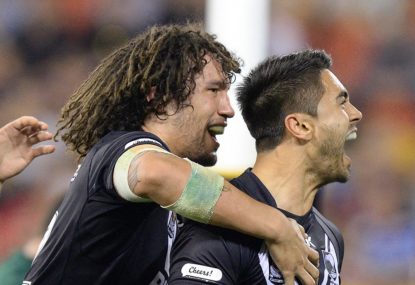Roar Guru

I am more of a rugby union guy than a rugby league fan, but I genuinely enjoy watching a good game in the NRL.
League has always been the more progressive code, it was the first to pay the players, adopt corner flags and embrace video technology.
Sunday’s grand final between the Broncos and Cowboys was as good as any sport gets. With that in mind there are a few more things union can learn from rugby league.
Let the players decide the contest
In Super Rugby this season there were 92 yellow cards and 10 red cards. In the NRL there were less than 20 players sent to the sin bin over the course of the whole season.
In league there doesn’t exist a real contest for the ball at each ruck so that contributes to the higher number of sanctions in union. But let’s be honest, how many cards would have been dished out in the NRL grand final if it was governed under union rules? I doubt anybody would have been left on the field.
In union the referees are far too quick to reach for the pocket. In the All Blacks versus Argentina World Cup match there were three yellow cards before half-time. If the referee had been consistent there could have been at least that many more in the second half.
I am not advocating foul play, but it’s wonderful to see players decide the contest.
In union there are more offences in which you can be penalised for. Maybe there needs to be two types of yellow card. A five-minute yellow card for minor offences like not rolling away and team warnings and ten minutes for more grave infringements.
Does the judiciary need to be more robust?
Whatever the solution, having three players sitting on the bench for half an hour in a marquee World Cup match is tragic.
Keep the ball in play
It’s difficult to attain precise figures on exactly how long the ball is in play for in each code, but watching rugby league it seems to flow a lot easier than rugby union.
In 2013, in the final regular season round of the NRL, the ball was in play for 78 per cent of the total game time. Comparatively in Super Rugby it was in play for 35 per cent of the game.
You could argue league perpetually stops. In the 2012 Anzac Test there were 600 stoppages, and a massive 575 of them were tackles. It takes about three or four seconds for the player to get up to play the ball so that works out to between 28.75 minutes and 38.33 minutes of the league Test spent playing the ball. That’s a lot of time in 80 minutes to watch a man hop up and roll the ball under his foot.
But in league there are less stoppages to restart play and the stopages don’t seem to drag on like in rugby. In Super Rugby in 2014 scrums averaged 13 minutes of the whole game.
Benefit of the doubt to the attacking team
The whole point of both games is to score more points than the opposition. Therefore union not providing the benefit of the doubt to the attacking team on disputed tries goes against that philosophy.
If the attacking team reaches the try-line of the defence that is a triumph for the offence, so why should the defence be granted compassion? Attacking play should be encouraged at all times shouldn’t it?
Stop the clock
During the last five minutes of an NRL match, the clock stops following a conversion or penalty kick at goal until play restarts at halfway. This interpretation has added excitement during close matches, provided greater consistency and reduced potential time-wasting.
Rugby should follow suit and introduce the same rule for scrums and lineouts. How many matches fizzle out lamely in the final minutes when they deserve a grandstand finish?